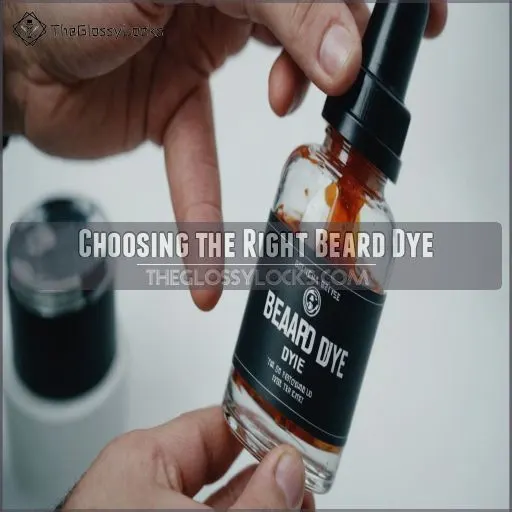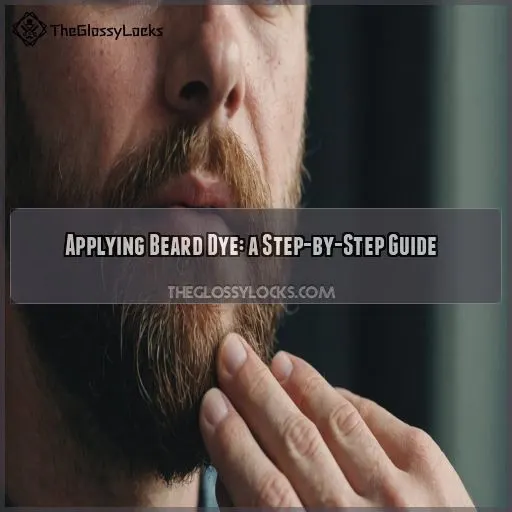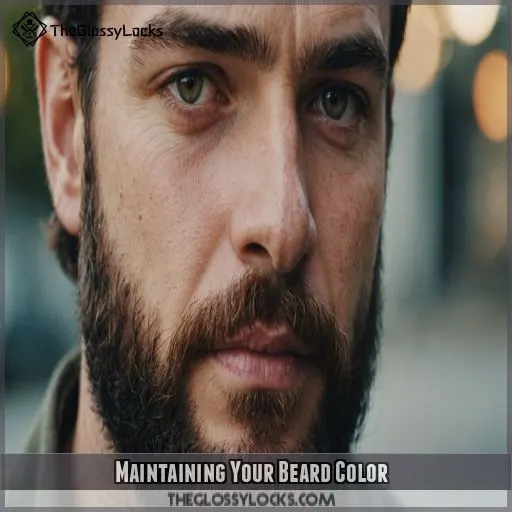This site is supported by our readers. We may earn a commission, at no cost to you, if you purchase through links.
 Dyeing your beard stubble is a breeze when you know the right steps.
Dyeing your beard stubble is a breeze when you know the right steps.
First, choose a beard dye shade slightly lighter than your desired color for a natural look.
Avoid regular hair dye – it can irritate your skin.
Prep your stubble by keeping it unwashed and dry before applying the dye.
Mix the color and developer creams, then apply with light, even strokes.
Focus on patchy areas first.
After the recommended time, rinse thoroughly and use alcohol wipes to clean up any mess.
Maintain your fresh look by reapplying dye as needed and using beard oil.
Easy peasy – now you can rock that perfect stubble color!
Table Of Contents
- Key Takeaways
- Choosing the Right Beard Dye
- Preparing Your Stubble for Dyeing
- Applying Beard Dye: a Step-by-Step Guide
- Cleaning Up After Dyeing
- Maintaining Your Beard Color
- Frequently Asked Questions (FAQs)
- Can I dye a stubble beard?
- How to darken beard stubble?
- Does beard dye work on short beards?
- How to dye stubble without staining skin black?
- What are the side effects of beard dye?
- How often should beard dye be reapplied?
- Can beard dye cause skin allergies?
- What should you do if you dislike the color?
- Are there any natural alternatives to beard dye?
- Conclusion
Key Takeaways
- Choose the Right Dye: Always go for a beard dye a shade lighter than your target color to keep things looking natural, especially if you’re dyeing a short beard. Stay away from regular hair dye – your face deserves better than skin irritation!
- Prep Like a Pro: Keep your stubble unwashed and dry. Those natural oils are like superheroes for color absorption, making sure your stubble gleams like a masterpiece in the gallery of life.
- Apply Carefully: Mix the color like a top chef and use light, downward strokes to apply. Focus on patchy areas first, like you’d fill in a paint-by-numbers masterpiece. Remember, there’s a thin line between artist and accidental abstract.
- Maintain Your Masterpiece: After dyeing, wash thoroughly and use beard oil for upkeep. Think of it like getting your car detailed after a wash – you want to keep that shine going strong!
Choosing the Right Beard Dye
Choosing the right beard dye is like picking out the perfect pair of socks; you want it to match your natural style without being too obvious. Opt for a slightly lighter shade than your goal, complement your hair color, and remember—no stealing your partner’s hair dye for that stubble!
Selecting a Shade for Natural Look
When choosing the right beard dye, opt for a shade slightly lighter than your desired color. This helps create a more natural, seamless look that complements your complexion. Avoid going too dark, as it can appear unnatural. Instead, select a hue that harmonizes with your natural hair color for a polished, well-groomed appearance.
Complementing Natural Hair Color
Once you’ve picked your shade, you’ll want to match it to your natural hair color. It’s like finding the perfect dance partner—one that moves seamlessly with your beard dye tips and hair color trends. Here’s the lowdown on color matching:
- Check your hair’s undertones.
- Choose harmonious colors.
- Balance to prevent unexpected color fading.
With these, your beard stubble will thrive!
Avoiding Regular Hair Dye on Stubble
It might be tempting to use regular hair dye on your stubble, but resist the urge.
Stubble, with its own texture and growth quirks, demands a dye specially formulated for facial hair.
Regular hair dye can cause skin irritation and unpredictable color consistency.
For a truly suave stubble beard, stick to products crafted for short beard hair and embrace expert beard grooming!
Purchasing Beard Dye Online or In-Store
You’ve nailed avoiding regular hair dye; now it’s time to grab a beard dye. Whether you’re browsing online for reviews or strolling into a store, the selection’s vast. Comparing prices and dye types lets you choose the best beard care option. Think of it as a treasure hunt for your beard’s perfect color companion, enriching your men’s grooming ritual.
Using a Color Chart for Visualization
Considering a color chart can help you visualize the final result and make an informed decision. Look for charts that show how the dye will blend with your natural hair color for a seamless, natural look. Just remember – charts aren’t perfect, so do a strand test to confirm the color before applying it to your full beard.
Preparing Your Stubble for Dyeing
Before you color your beard, keep it unwashed, so your natural oils can work their magic on the dye. Also, make sure your stubble is dry; a wet beard is like a canvas in a rainstorm—it dilutes the masterpiece!
Starting With Unwashed Face and Stubble
Choosing your dye leads us to the unwashed face routine. Starting with an unwashed face and stubble might feel odd, but it’s a game-changer. Natural oils impact the success of beard dye absorption, promoting a richer color like beard oil. Think of it as nature’s conditioner—you won’t want to wash away the skin oil benefits that help your beard prep perfectly.
Avoiding Face Washing Before Dyeing
Avoid washing your face before dyeing to keep natural oils intact. This pre-dye routine enhances dye absorption and minimizes skin irritation. Stick to these tips:
- Delay face washing for at least a day.
- Embrace the unwashed look—your beard will thank you!
- If you must shower, keep your face dry.
- Enjoy the added oil production benefits.
Minimizing Risk of Washing Away Natural Oils
Avoid washing your face for at least a day before dyeing to maintain the natural oils that help the color absorb evenly. If a shower is necessary, focus on cleaning your body from the neck down to minimize disrupting the oils on your face. This prepares your stubble for a good dyeing experience.
Ensuring Stubble is Dry Before Application
Alright, let’s make sure your stubble is dryer than the Sahara before you start painting the Picasso on your face. Why?
- Dry stubble helps the dye absorb better.
- It keeps the dye consistency just right.
- Enhances the color result for those sought-after vibrant tones.
- A good match, hair texture and dry stubble make a masterpiece.
Happy coloring!
Applying Beard Dye: a Step-by-Step Guide
Get ready to rock your beard by applying dye with our easy steps that promise seamless color. It’s almost like painting a masterpiece, but instead of a canvas, it’s your stubble – just remember, nobody likes a spotted Picasso, so apply carefully!
Mixing Color Base Cream and Developer Cream
Ready to start dyeing? Begin with equal parts color base cream and developer cream.
A 1:1 mixing ratio makes sure the cream is the right consistency.
Want control over color depth? Adjust developer strength according to the instructions.
Think of it as a paint palette for your stubble.
Before you know it, you’ll master the application technique and ace your beard game!
Blending Creams for Uniform Color
Blend the color base cream and developer cream together in the provided tray until you achieve a uniform, consistent mixture. This makes sure the dye applies evenly across your stubble, avoiding any unsightly streaks or patchiness. Mix the creams thoroughly using the applicator brush for a smooth, blended result.
- Mix equal parts of the two creams.
- Blend the mixture until it’s uniform in color.
- Use the applicator brush to thoroughly combine the creams.
Applying Dye With Light Downward Strokes
To apply beard dye, don’t rush. Gently brush the dye onto your stubble using light downward strokes, like painting a masterpiece. This technique helps create even color distribution and helps prevent those dreaded harsh lines. Remember, your stubble’s like a delicate canvas—treat it with care, and it’ll respond with stunning results. Voil, a well-groomed stubble!
Focusing on Lightest or Patchiest Areas First
When applying beard dye, focus on those patchy areas for even coverage is key! Start with the lightest spots, like an artist filling in a canvas, ensuring a consistent, natural look. Think of it as adding brushstrokes of color, bringing your beard to life. This careful approach will have you mastering the art of dye application in no time!
Applying Dye in a Well-Ventilated Area
After focusing on those patchy spots, remember that you’re not painting a portrait—you’re diversifying your beard’s portfolio!
You’re not just adding color, you’re adding depth and dimension.
Head to a well-ventilated spot, like an open window or porch, to apply the dye.
Breathing in fresh air while protecting your lungs from the medley of chemical fumes will help keep your respiratory health in good shape.
Safety precautions mean smooth sailing!
Cleaning Up After Dyeing
Once you’ve applied the beard dye, it’s time to clean up. Use alcohol-based wipes to quickly remove any excess dye that may have spilled onto your skin, especially along the edges of your stubble. This will help prevent unsightly staining and keep your look polished.
Removing Excess Dye With Alcohol-Based Wipes
Dye stains happen to the best of us.
A quick swipe with the best wipes, preferably alcohol-based, will do the trick.
These nifty tools tackle potential skin irritation while saving face.
If you’re in a pinch, try alternative methods like dish soap.
Just remember, safety tips and a steady hand are your friends.
Wiping Along Edges of Stubble
Ensuring clean edges is like having a tidy workspace—vital for avoiding dye transfer and skin irritation. After applying dye, use alcohol-based wipes to gently wipe along your stubble’s perimeter. This prevents unwanted stains and keeps your look sharp. Remember:
- Dye Removal: Focus on hairline edges.
- Gentle Touch: Avoid excessive pressure.
- Laugh It Off: Oops moments happen!
Acting Quickly to Prevent Staining
You’ve tackled wiping those dye edges, but don’t rest on your laurels just yet! Act fast to prevent stains. Think of it as a race against time: the dye’s setting faster than a speeding bullet! Use those trusty alcohol-based wipes before it bonds like glue. Remember, quick clean-up techniques are your trusty sidekick in this hair-color adventure.
Washing Out Dye After Recommended Time
Be sure to wash out the dye after the recommended time specified on the product instructions. This makes sure the dye develops properly and achieves the desired color. Use lukewarm water and a gentle shampoo or soap to thoroughly cleanse the stubble, removing any excess dye and preventing staining.
- Avoid hot water, as it can cause the dye to bleed and spread.
- Rinse thoroughly to remove all traces of the dye.
- Pat dry gently with a clean towel.
- Apply a moisturizing beard oil or balm to condition the hair.
- Style as desired and enjoy your new, vibrant beard color!
Removing Dye From Other Areas of Skin
Got dye on your skin? Don’t fret! Grab alcohol wipes — they’re superheroes for dye stains. Gently swipe them over the area to avoid unwanted tattoos. Just like you’d tackle a spaghetti stain, be quick about it! Here’s a quick guide:
| Problem | Solution |
|---|---|
| Stains | Alcohol Wipes |
| Irritation | Moisturizer |
| Missed spots | Stay calm |
Your skin will thank you!
Maintaining Your Beard Color
Want to keep your beard looking sharp? Stick to the recommended dye time, wash thoroughly afterwards, and use a bit of beard oil to keep it looking fresh and vibrant!
Leaving Dye in for Recommended Time
While cleaning up, you’ve managed to keep the dye off your skin, but how long do you wait? The magical number:
- Dyeing Time – 5 minutes, or as instructed.
- Color Development – Watch it bloom!
- Timing Variations – Everyone’s different; follow your product’s guidance.
- Over-Dyeing Risks – Leave it too long, and you might sport an unexpectedly dark masterpiece!
Washing Stubble Thoroughly After Dyeing
After letting the dye work its magic, it’s time to wash that stubble thoroughly. Use lukewarm water and a gentle, sulfate-free shampoo to rinse out any excess color. Avoid hot water, as it can strip the dye. Finish with a moisturizing conditioner to keep your freshly dyed beard soft and healthy.
| Dyeing Frequency | Water Temperature | Shampoo Type | Conditioner Use | Color Fading |
|---|---|---|---|---|
| As needed | Lukewarm | Sulfate-free | Recommended | Minimized |
Using Argan Oil or Beard Oil for Maintenance
Hey, beard maestro! Argan oil and beard oil are your secret weapons against color fade. Their benefits? Think of them as the shield preserving your beard’s vibrant hue. Choose an oil type that suits your style, and apply often, like you’d water a favorite plant. It’s simple—rub a few drops in, and you’re good to go!
Applying More Dye as Needed for Consistent Color
You’ve nailed the color maintenance part, dabbing on a bit of argan oil. But as the weeks drift by, you’ll notice some color fading—like the party guest who starts fading into the wallpaper. That’s when a touch-up dye comes in! Set a re-dyeing schedule based on your dyeing frequency. Keep it up, and you’ll master this, no sweat.
Frequently Asked Questions (FAQs)
Can I dye a stubble beard?
Absolutely, you can dye your stubble beard, like a painter adding the final stroke to a masterpiece. Just make sure you use beard-specific dye, apply it carefully, and remember, slow and steady wins the race for natural color.
How to darken beard stubble?
To darken beard stubble, choose a beard dye slightly lighter than your hair color, following the instructions for applying beard dye. Apply it evenly using a brush, focusing on patchy areas. Let the dye sit, then rinse thoroughly. It’ll look naturally fuller!
Does beard dye work on short beards?
Absolutely, beard dye can work wonders on short stubble, painting your face with a fresh, vibrant hue. Just be sure to choose the right shade and follow the steps carefully – it’s a game-changer for your rugged look.
How to dye stubble without staining skin black?
To avoid skin staining when dyeing your stubble, apply petroleum jelly around your beard as a barrier like a pro. Use light strokes and avoid pushing the dye into your skin. If needed, quickly wipe mishaps with alcohol-based wipes.
What are the side effects of beard dye?
Beard dye might irritate your skin, cause allergic reactions, or dry out your hair. It’s like trying to tame a wild horse—handle with care, do a patch test first, and don’t skip the instructions!
How often should beard dye be reapplied?
Think of your beard like a moody teenager—it’ll need attention every 3-6 weeks, depending on how fast your hair grows. If it starts fading or patchy, grab that dye and refresh your look!
Can beard dye cause skin allergies?
Absolutely, beard dye can cause skin allergies. It’s like playing a game of facial roulette! Always do a patch test before diving in; better safe than sporting a red, itchy beard. Your skin will thank you!
What should you do if you dislike the color?
Imagine you’ve dyed your beard orange instead of brown. Don’t panic! Simply apply a clarifying shampoo to help fade the color faster, or try a color remover. It’s like hitting the undo button for your beard.
Are there any natural alternatives to beard dye?
For a natural alternative, try using coffee or black tea to darken your beard. Steep it well, apply thoroughly, and let it sit. Just remember, it might take a few rounds to achieve a noticeable effect!
Conclusion
Believe it or not, 80% of men dye their beard stubble to achieve their desired look.
With the right beard dye and a bit of know-how, you too can rock that perfect stubble color in no time.
Just remember to choose the right shade, prep your stubble, and apply the dye carefully.
Follow these easy steps, and you’ll be on your way to flawless, dyed beard stubble that’ll have everyone asking for your secret.








